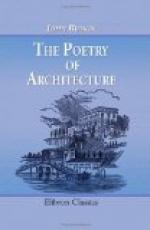6. Not so in architecture. There, the power is generally diffused. Every citizen may box himself up in as barbarous a tenement as suits his taste or inclination; the architect is his vassal, and must permit him not only to criticise, but to perpetrate. The palace or the nobleman’s seat may be raised in good taste, and become the admiration of a nation; but the influence of their owner is terminated by the boundary of his estate: he has no command over the adjacent scenery, and the possessor of every thirty acres around him has him at his mercy. The streets of our cities are examples of the effects of this clashing of different tastes; and they are either remarkable for the utter absence of all attempt at embellishment, or disgraced by every variety of abomination.
7. Again, in a climate like ours, those few who have knowledge and feeling to distinguish what is beautiful, are frequently prevented by various circumstances from erecting it. John Bull’s comfort perpetually interferes with his good taste, and I should be the first to lament his losing so much of his nationality, as to permit the latter to prevail. He cannot put his windows into a recess, without darkening his rooms; he cannot raise a narrow gable above his walls, without knocking his head against the rafters; and, worst of all, he cannot do either, without being stigmatized by the awful, inevitable epithet, of “a very odd man.” But, though much of the degradation of our present school of architecture is owing to the want or the unfitness of patrons, surely it is yet more attributable to a lamentable deficiency of taste and talent among our architects themselves. It is true, that in a country affording so little encouragement, and presenting so many causes for its absence, it cannot be expected that we should have any Michael Angelo Buonarottis. The energy of our architects is expended in raising “neat” poor-houses, and “pretty” charity schools; and, if they ever enter upon a work of higher rank, economy is the order of the day: plaster and stucco are substituted for granite and marble; rods of splashed iron for columns of verd-antique; and in the wild struggle after novelty, the fantastic is mistaken for the graceful, the complicated for the imposing, superfluity of ornament for beauty, and its total absence for simplicity.
8. But all these disadvantages might in some degree be counteracted, all these abuses in some degree prevented, were it not for the slight attention paid by our architects to that branch of the art which I have above designated as the Poetry of Architecture. All unity of feeling (which is the first principle of good taste) is neglected; we see nothing but incongruous combination: we have pinnacles without height, windows without light, columns with nothing to sustain, and buttresses with nothing to support. We have parish paupers smoking their pipes and drinking their beer under Gothic arches and sculptured niches; and quiet old English gentlemen reclining on crocodile stools, and peeping out of the windows of Swiss chalets.




